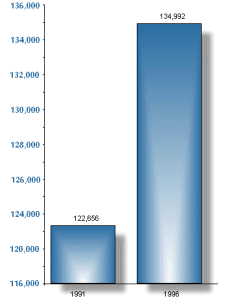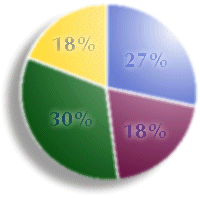|
Kildare has seen a significant increase in population
in recent years.
|
|
This is due to a national increase in population,
the expansion of Dublin, the return of many
former emigrants and the growth of new settlements
to house employees of new industry. Kildare
is increasingly viewed as an attractive alternative
to living in Dublin. This contributes to a growing
labour force within the county. The graph on
the right shows how the population of Kildare
has increased by over 10,000 between the years
1991 and 1996. In 1996, 45% of Kildare’s
population were under 25 years. This will create
a large future workforce in the county.
|
|
Population
growth in Kildare between 1991-1996
(Source –gamma
stats)

|
|
Age
Distribution in Labour Force Kildare -1996
(Source
- Gamma stats)
|
  The
county's Labour Force Participation rate is 58.2%. The county
has a high education and skills level. This is the result
of a culture where great emphasis is placed on education.
The Irish government has invested heavily in the provision
of a high quality education system, including free education
to third level. Great emphasis is placed on participation
in third level education, with Ireland recording a third
level participation rate of up to 50%. The result is many
graduates with varied academic and technical backgrounds
in the younger age groups of the Labour Force. The
county's Labour Force Participation rate is 58.2%. The county
has a high education and skills level. This is the result
of a culture where great emphasis is placed on education.
The Irish government has invested heavily in the provision
of a high quality education system, including free education
to third level. Great emphasis is placed on participation
in third level education, with Ireland recording a third
level participation rate of up to 50%. The result is many
graduates with varied academic and technical backgrounds
in the younger age groups of the Labour Force.
Labour Force and Level of Education achieved (Source
- Gamma stats) |
|

|
|
Kildare
has its own University
at Maynooth. There is easy access to many universities
and third level colleges in Dublin and surrounding counties.
Intel’s
Communications Manager reported it’s prime motivating
factor for establishing their European Headquarters in
Kildare was the availability of a highly, skilled, competitively
priced workforce and an attractive residential area for
their workforce
|